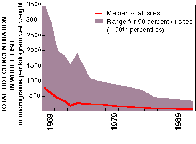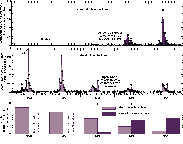
Pesticides in streams and ground water change over time as the types and amounts of chemicals in use change. With the exception of organochlorine insecticides, however, consistent data that are adequate for assessing long-term trends have not been widely collected. Examples for the organochlorine insecticides and recent changes in herbicide use illustrate the importance of tracking such trends.
 |
| image size 8KB--gif |
A striking historical trend is the reduction in concentrations of organochlorine insecticides in sediment and fish following restrictions on their use, yet they continue to occur at levels of concern. This trend is evident in sediment cores from lakes and reservoirs and by comparison of NAWQA findings to historical concentrations in fish measured by the U.S. Fish and Wildlife Service (USFWS).
As sediment erodes from the land surface over time, it is deposited in layers on the bottom of lakes and reservoirs. Age-dated sediment cores that penetrate these layered deposits can be used to track trends in sediment-associated contaminants within the drainage basin. Concentrations of total DDT (DDT plus breakdown products DDE and DDD) in sediment cores from lakes and reservoirs reflect high historical use of DDT followed by a ban in 1972. DDT concentrations peaked during the 1960s, which coincides with its peak use as an insecticide. Total DDT concentrations in sediment have decreased since 1972 in all sampled lakes and reservoirs that drain urban and agricultural areas within the United States.(45)
 |
Unlike DDT, aldrin and chlordane were used for termite control until the late 1980s, long after their agricultural uses were cancelled in the early 1970s. Chlordane and dieldrin concentrations peaked in many agricultural areas during the 1970s, and decreased thereafter. In some urban lakes and reservoirs, however, such as White Rock Lake in the Trinity River Basin, chlordane and dieldrin peaked much later, probably as a result of continued urban use during the 1980s. This watershed is dominated by new (post-1960) urbanization.(46)
Concentrations of DDT, chlordane, and dieldrin in whole fish have declined nationally since the 1970s. To assess trends in DDT concentrations, NAWQA data for streams and rivers with mixed land influences were compared with similar data from 1969 to 1986 collected by the USFWS National Contaminant Biomonitoring Program.(47) Total DDT concentrations in fish declined markedly from 1969 to the present. The declines were greatest during the early 1970s, with concentrations since the mid-1980s showing a slower decline or even a plateau.
Despite the observed national decline in total DDT concentrations, the detection frequency for total DDT in whole fish from major rivers remains high (94 percent in the 1990s), and locally contaminated areas persist. This is probably caused by the presence of total DDT in the streambed and continued inputs of total DDT to hydrologic systems as contaminated soils erode into streams.
 |
Few studies have documented long-term trends in water concentrations of currently used pesticides with sufficient consistency in locations, timing, and methods to be conclusive. Recently, however, a major change has occurred in herbicide use patterns for corn and soybeans, with a new compound, acetochlor, partially replacing alachlor beginning in 1994. The increase in acetochlor concentrations and decrease in alachlor concentrations in the White River from 1994 through 1996 illustrate the direct connection between chemical use and concentrations in streams and in the major rivers into which they flow.
Generally, as pesticide use in a basin changes, concentrations in streams quickly reflect these changes. In ground water, however, responses to trends in pesticide-use patterns will be highly variable depending on the nature of the flow system and variability in flow pathways, well depth, and other factors. For the most part, changes in concentrations of pesticides in ground water are much slower than in streams, and responses of ground water to changing use can be delayed for years or decades in some systems.
| References | |
| Differences in occurrence and behavior of pesticides complicate evaluation of potential effects | |
| The Quality of Our Nation's Water--Nutrients and Pesticides |